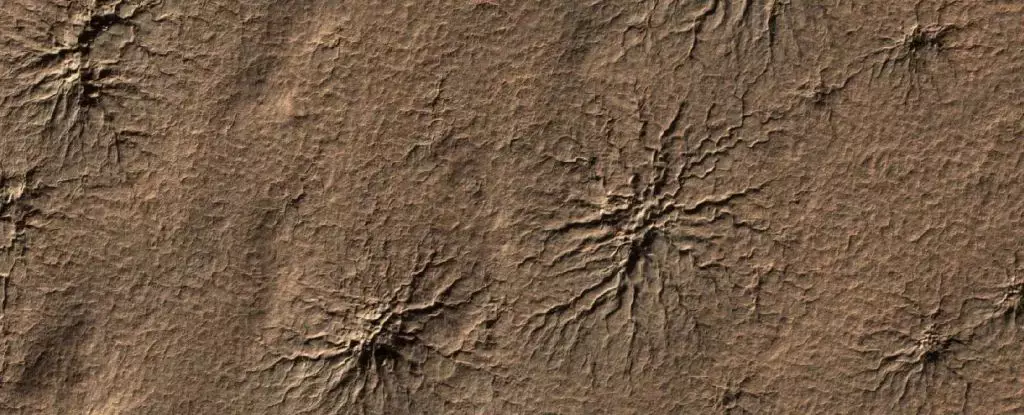Mars, often referred to as the red planet, has captivated the imaginations of scientists and enthusiasts alike with its strange and unique geological phenomena. Among these are the enigmatic formations known as araneiforms, which resemble spiders scuttling across the Martian surface. However, these formations are not what they seem. They are not living creatures but rather complex structures created through geological processes. Understanding these formations could provide crucial insights into the climatic and atmospheric conditions that define Mars.
The araneiforms are particularly prominent during Mars’ spring season, appearing in the southern polar region. Their spider-like shapes are formed on the planet’s dusty surface, where conditions vary dramatically from what we encounter on Earth. These unique formations have puzzled researchers for years, raising questions about their origin and the processes involved in their creation.
The mechanisms that lead to the formation of araneiforms can be traced back to the behavior of carbon dioxide in the Martian environment. Unlike Earth, where carbon dioxide can exist in liquid form under certain conditions, on Mars, it sublimates directly from a solid state to a gas. This occurs particularly in the southern polar region, where temperatures drop low enough for carbon dioxide to freeze into ice.
When winter succumbs to the warmth of spring, the frozen carbon dioxide undergoes sublimation. The emergence of heat from the underlying darker regolith accelerates this process. The sublimated gas becomes trapped beneath the ice, creating a build-up of pressure due to the confined space. Eventually, this pressure develops to the point where small explosions can occur, creating channels or cracks in the ice as the gas escapes, leaving behind dark trails that resemble the fine legs of spiders.
The leading theory surrounding the formation of araneiforms is known as the Kieffer model, named after geophysicist Hugh Kieffer, who proposed this mechanism. Kieffer’s research revealed that the changes in temperature and the unique behavior of carbon dioxide could explain the emergence and patterning of these spidery features across the Martian landscape.
Recent experiments conducted by scientists, including Lauren McKeown from NASA’s Jet Propulsion Laboratory, have sought to simulate these natural processes to confirm the validity of the Kieffer model. By recreating the harsh Martian environment in a controlled laboratory setting, McKeown and her team were able to observe the conditions under which araneiforms form.
To replicate the Martian environment, McKeown’s team utilized a device known as the Dirty Under-vacuum Simulation Testbed for Icy Environments (DUSTIE). This advanced apparatus allowed the researchers to control pressure and temperature while utilizing simulants that mimic Martian regolith. The experiment involved freezing carbon dioxide onto the simulant in conditions resembling those found during Martian winter.
As they meticulously adjusted the conditions within the chamber, the team reached a pivotal moment when the ice encapsulating the gas ruptured, mimicking the formation of araneiforms on Mars. Intriguingly, the surprise revelation from these experiments was that ice formed within the dirt layer rather than between the dirt and ice, which suggested new implications for understanding Martian geology.
The confirmation of the Kieffer model and the success of simulations opens up new avenues of understanding regarding seasonal changes on Mars. This knowledge holds relevance not only for the formation of araneiforms but potentially other geological features as well.
As scientists continue to study the complexities of Martian geology, it may also influence future missions to the planet. Armed with a clearer understanding of these processes, researchers can develop refined models to predict and explore unexplored areas of Mars, potentially paving the way for discoveries that may shed light on the planet’s history and atmospheric evolution.
The study of these bizarre Martian formations enriches our understanding of the planet itself and underscores the uniqueness of its geological features. As we decode the mysteries of the red planet, we inch closer to grasping its broad and often enigmatic dynamics—highlighting just how vastly different planetary environments can be from our own.


Leave a Reply